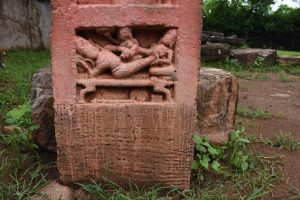INIG1177a Indor Inscription of VS 1177

Indor (District Guna). Hero-stone pillar inscription of VS 1177 (INIG1177a)
INIG1161 Gowalior Fort Inscription of VS 1161
INIG1161 māgha śudi 6 Gwalior fort (Gwalior). From a Śiva temple. 9 lines, nāgarī, Sanskrit. Fragmentary inscription mentioning the Kacchapaghāta rulers Bhuvanapāla, Devapāla, his son Padmapāla and Mahīpāla. Records that Manoratha, a Māthura kāyastha, was married to Bhāvā (?) and that he was a servant of Bhuvanapāla. Their son was Mānicandra and he built a temple of Śiva (Smarārāti) and some other gods. Further recounts that Mānicandra was married to Rāsagati and that their sons were Madhusūdana and Āśācandra. The later (i.e. Āśācandra) built the present temple of Hara. Composed by the Jaina sage Yaśodeva. Now in the State Museum, Lucknow.
INIG1160 Gowalior Fort Inscription of VS 1160
INIG1160 kārttika śudi 13 guruvāra Gwalior fort (Gwalior). On the Sās Bahū temple near the door of the sanctum. Number of lines not given, nāgarī, Sanskrit. Damaged; seems to record some construction by a certain Mahindu. The writer was Ratana.
INIG1152 Dubkund Inscription of VS 1152
INIG1152 vaiśākha śudi 5 Dubkund (Sheopur). On the base of pādukā in a Jaina temple. 4 lines, nāgarī, Sanskrit. Mentions double pādukā of Kāṣṭhasaṁgha mahācāryavarya śrī Devasena.
INIG1150 Gowalior Fort Inscription of VS 1150
INIG1150 Gwalior fort (Gwalior). Two slabs in the porch of the Sās Bahū temple. 22 lines (right side) + 21 lines (left side), old nāgarī, Sanskrit. Describes the construction of and donations to Padmanātha (i.e. Viṣṇu) by the Kacchapaghāta ruler Mahīpāladeva. The main kings of the Kacchapaghāta dynasty are given in the inscription as: Lakṣmaṇa and his son Vajradāman (who defeated the king of Kannauj and conquered Gopādri); Maṅgalarāja; Kīrtirāja and his son Mūladeva (known as Bhuvanapāla and Trailokyamalla) who married Devavṛttā; his son Padmapāla; his heir Sūryapāla and his son Mahīpāla Bhuvanaikamalla who was a brother of Padmapāla. Composed by Maṇikaṇṭa, son of Govinda and the grandson of Rāma; written by Digambara Yaśodeva and inscribed by Padma Siṁhavāja and Māhula, sons of Devasvāmin.
INIG1145 Dubkund Inscription of VS 1145
INIG1145 bhādrapada śudi 3 Dubkund (Sheopur). On a slab from the ruins of a Jaina temple. 61 lines, old nāgarī, Sanskrit. Genealogy of Kacchapaghāta mahārāja Vikramasiṁha. Arjunasiṁha, son of Yuvarāja, killed Rājyapāla (of Kannauj) at the insistence of Vidyādhara, the Candella ruler at Khajurāho. The son of Arjuna was Abhimanyu (in the time of Bhoja) and the son of Abhimanyu was Vijayapāla and that of Vijayapāla was Vikramasiṁha. Composed by Vijayakīrti son of Śāntiṣeṇa written by Udayarāja and incised by Tīlhaṇa. Now in the Archaeological Museum, Gwalior.
INIG1132a Pachrāi Inscription of VS 1132a
INIG1132a Pachrāi (Shivpuri). On a pillar in one of the Jaina temples. 6 lines, nāgarī, corrupt Sanskrit. The inscription is broken.
INIG1124 Lakhārī Inscription of VS 1124
INIG1124 Lakhārī (Guna). From a step well. 6 lines, nāgarī, corrupt Sanskrit. Mentions a grant of 200 siddhidramma by Jahlaṇadevī, wife of rājaputra Candrāditya in the time of mahārājādirāja Abha[ya]deva. Now in Archaeological Museum, Gwalior.
INIG1122 Pachrāi Inscription of VS 1122
INIG1122 Pachrāi (Shivpuri). On slab in a shrine of Śāntinātha. 8 lines, nāgarī, corrupt Sanskrit. Mentions one Harirāja and his son Raṇamāla (i.e. Raṇapāla). Begins with a verse in praise of Śāntinātha; refers to Bālacaṁdra, the disciple of Subhanaṁdi belonging to Kuṁdakuṁdasaṁtāna and Deśikagaṇa. Mentions the ruler Raṇapāla and his forbears Harirāja and Bhīma. Gives the genealogy of a person named Maheśvara belonging to Parapāṭānvaya. His son was [De]vi and his son was Rājana, who is stated to have made the kīrtti. At end mentions two goṣṭhikas one of which was Jasahaḍa.
INIG1118 Chitārā Inscription of VS 1118
INIG1118 Chitārā (Sheopur). On a pillar. 3 lines, nāgarī, Prakrit. Not legible.